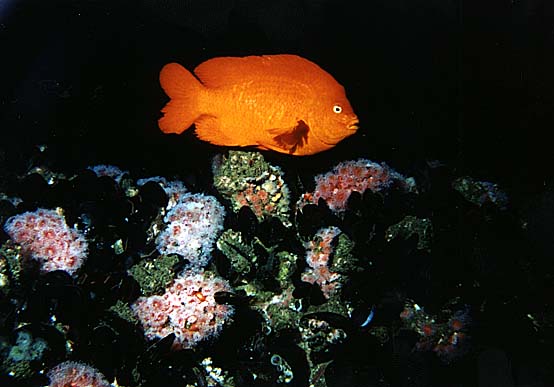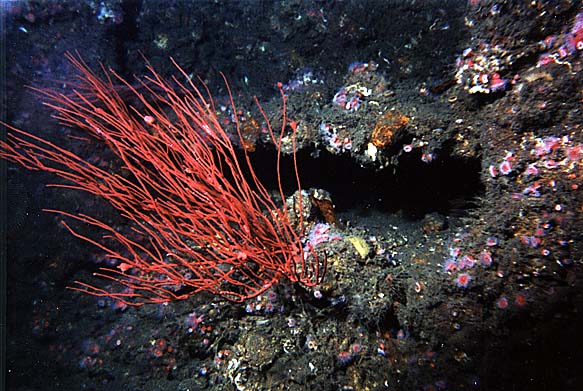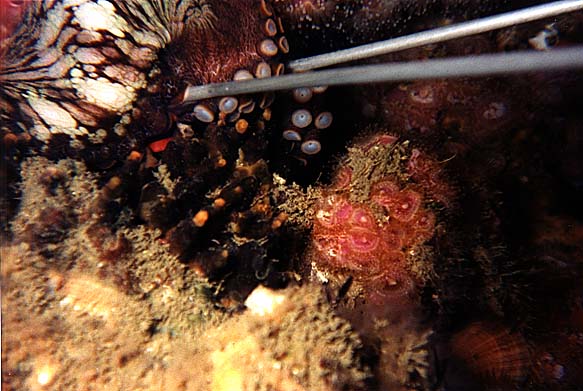
The Moody was sunk in the filming of Hell Below in 1933 and sits in about 148 ft of water. The filming crew sawed it in half and then bolted it together so that it would sink in two pieces. It was said to be a very dramatic scene, used in other movies, but the movie looks to be completely out of print now. In any event, you have two main pieces on a sandy bottom. It was initially rediscovered by divers in the 70s, who were looking for a freighter that went down in the 50s, but eventually they were able to identify it as the Moody after findind a plate with the ship ID on it.
Sadly, it was not my luck to dive it on this trip. (I included the description mostly because I could find none on the net last week). Mike (or was it Troy?) dropped down in what appeared to be clear waters to discover near zero viz below 70ft. While we could feel the wreck, it probably would be a really stupid idea, so we bailed. The boat will be going back there in the summer; I'll catch it then or on the next run. I'm going to sidetrack for a moment to talk about the Great Escape , the boat that ran this charter. Captain Tim runs a very easy going outfit. The code of the responsible diver is the golden rule: you're pretty much free to dive as you like; you're expected to dive within your limitations. The boat is very wide, and for our limited load was quite spacious. I particularly appreciated the 'state room' downstairs that was reserved for me. It had two typical bunks and enough floor space to stand times the length of the bunk. No sharing the bunk with my dry gear. And as importantly, it had a door so I could filter out noise and light well. There were 6 of these rooms and then typical bunks down the middle. Probably enough for those of us driving down from far away; the locals don't need them.
On these trips, the boat served up breakfast and lunch, and had fountain drinks on tap. Lunch was good both days, but breakfast was a bit limited in terms of my tastes (warm stuff was scrambled eggs, hash browns, and bacon). Not bad, but it seemed less exciting on the second day. We had 3 crew members onboard in addition to the DM/safety divers. They did air fills, meals, and helped out in general. On the second day, we had a light load and had about as much help as divers. Things were really smooth.
Now let's get to actual diving!
So...we motored over to the oil platforms that are about 6 miles off the Huntington Beach coast. Cap't Tim apparently has a pretty good relationship with the oil company and usually is permitted to dive there if there is no conflicting activity. The two main rules are no anchoring and divers should stay clear of the loading dock on one side. The rig itself looked entirely unmanned, with just a fire spout showing activity.

Oil Platform Edith sits in 165 ft of water. That makes it one of the shallower ones around, but even it is deep enough that you have to control your bouyancy (duh). Or not - there were people on board with doubles and no BCs. Many of the tech divers went to the bottom. We had people on air, nitrox, and trimix on the boat. Some entered with doubles and a full sized cylinder staged on each side. There was a single Spare Air on board, but it was nitrox filled and used as a bailout bottle for a guy on a Draeger rebreather. There were quite a few backplate and wings people. Had Carl made it I would have been able to get a good look at a Halcyon model too.
I stuck with the plan of going to the 140s to make sure my gear would have checked out ok. I didn't want to go further as I think it's best to increase your max depth gradually - the deepest I'd seen in California waters was 124ft before. I ended up going to that depth twice because the first time I forgot to check my pony reg's performance at depth. After a few minutes down deep, I'd work up level by level.
The bottom was sandy, but full of star fish and other colored items. I could see it quite clearly on the second dive at about 140'. At this depth, it was getting dark, but you could still see a lot/distance by ambient light. At 80', I could see the sun shining through the surface. Very spectacular for California, especially with the shape above. The oil platform might best be described as a cylinderical Eiffel Tower, with vertical and diagonal beams on the sides, and with 3 flat platforms between the surface and the bottom at 40 ft intervals. I think they were at 110, 70, 40, or something in the ballpark of that. These levels weren't solid - one had a lot of portholes and others were like a grid with enough space to carefully glide through. Surge was pretty light, with a slight up/down motion in some parts.

From the bottom to about -140, metridium anemonies dominate the beams.
Perhaps it is due to clearer waters that they only exist so deep. In some
Monterey Bay sites, you see them as shallow as 45-50 ft. Above that was
the scallop layer - the rock scallops and coryanctis dominate to about 40'
where the barnicles start their control .
Ochre stars are common, especially very pretty
purple ones . The fish start showing up on the middle platform at -70,
including a very large cabezon that was lying in wait. At about -50,
there were large numbers of fish, especially the ones noticing my bad
attempts at harvesting scallops. (I was using the wrong tool to get them
out of shell, and as a result the fish got good eating) Garibaldi were
present, but somewhat uncommon. The rest I can't specify - I'm talking a
bio class this spring to improve on this. At one point I noticed a large
shadow go by in the right corner of my eye and I turn to see a 6' sea lion
flying by. It made a few passes and went on with its business.
Afterwards I could make out a dozen or so in the vicinity of or on the
rig. After running my tank down at 15', I surfaced and headed over to the
drifting boat.
Dive #1: 144ft max, dive time 40 mins. EAN26
Dive #2: 143ft max, dive time 46 mins. EAN26

By now it is afternoon and the winds are picking up a bit. We start
motoring back towards LA harbor with a stop at the site of the Olympic, a
wreck at about -100 ft. Currents are now an issue, as I discover when I
jump in sans gloves, a decision I'll learn to regret later. Viz on this
dive is piss poor, probably not much better than the Moody was. At -70 I
run into a reef, puzzling me since the wreck was to be at -100. It was of
course the hull. This wreck has been there for a while, I'd say, and with
viz < 10 ft it's hard to see a structure. At the bottom, I could see
several vertical columns with a dark inside. There was a reel leading
into this that I was considering following, but then the owner came out
with it. I decided to go left initially along the wreck and came about
to the end. But as I crossed over I was suddenly hit by the strong
currents. Not wanting to be swept off the wreck, I grabbed for purchase
and managed to get a number of cuts on my left hand. I then went back the
way I came and went to the upcurrent side. Eventually I could get inside
the hull and take a look. It was heavily covered with anemonies and other
color, but I really wasn't in the state of mind to enjoy it. A reel would
have been most welcome here. I then surfaced without incident. I took a
very small number of macro shots here, not yet developed.
Dive #3: 98ft max, dive time 31 minutes
And that was it for the day. We went back to harbor, loaded up our nitrox tanks in my car and headed out for refills with 28-29%. My parents came over for dinner and then I went back to bed, waking up about the time the boat had left the harbor.
The primary site was the wreck of the Palawan, a rather large freighter that probably hasn't been there too long. Its top was at about -100, the bottom as deep as 140. Thankfully viz was quite good here, probably a good 40 or so. This allowed me to actually see the formation, key as it was essentially a series of very large boxes: perhaps 50ft wide, 20some ft deep and longer than I could swim to in a time I was comfy with. There were open doorways between each region, so I was often dropping down to swim through the hatch and then coming back up and skimming along the top deck. I did encounter a large internal hatch that I eyeballed, but I didn't want to venture past the entrance. Terry gave me a reel for this dive, but it wasn't necessary, and I didn't want to spend dive time in there.

I had the camera, but this unfortunately wasn't ideal. While I could see
wide angle quite well, the light levels was low and any sense of scale
wasn't going to fit within the 6' flash range. I instead focused on
smaller objects that are clearly non reef. There was a lot of red algae
at this depth that I find very pretty. I learned in my bio class this
last week that red algae (seaweed) uses blue-green light for
photosynthisis, the light present at this depth. This site was as fun as
the oil platforms.
Dive #1: 122ft max, dive time 26 minutes. EAN29
Half the customers this day were in an Advanced class. I think for that reason we moved onward to somewhere a bit shallower. We went a bit south down Palos Verdes to Dominator, a popular spot for game hunting. It also had quite a few lobster traps, not to mention lobster boats. This is potentially a problem - there is a bit of tension between divers and lobster boats, the latter not terribly interested in respecting the waters around a diver down flag.
The current here was intense. A diver doing the giant stride would
surface 10ft down from where he jumped. Just getting to the anchor line
was a pain. I passed on the camera and went down to see what game I could
find. I attempted to swim upstream of the anchor, but it was incredibly
difficult to make headway. I gave up on that and decided just to watch
and see what would come by. Viz was excellent at 40+ and I could make out
the boat and the entire anchor line above me if I remained in the region
just below. Unfortunately, not much happened. It probably wasn't worth
the nitrox fill and I came up long before air required.
Dive #2: 62ft max, dive time 35 minutes. EAN29
By now I have been convinced that I should reconsider my time table for buying a drysuit. I'm feeling colder today, and yesterday I was concerned about the safety of my profiles when adding cold to the mix. I also had a good conversation with a Peter DenHaan, a rep for Mobby Drysuits.
Dive site three was further south and a bit more protected at Pt. Vicente.
Current was not an issue here, but our friend surge was back. It was
quite entertaining trying to swap lenses between two aquashot cameras on
this dive - I was shifting 15' back and forth while doing so! This area
has many large rock pinnacles just below the boat. The tops were at
13-25ft, the bottoms at about 45. But the surging water between each rock
was pretty powerful and seemingly always against me. I saw a lot of a
type of anemonie I wasn't familiar with nestled in with the barnicles. It
was perhaps 1.5" wide, an inch tall and quickly withdrew in when I tried
to move in for a shot. It might have been the aggregating anemonie.
The notable event of this dive was when I came upon an
octopus sleeping out the wild waters in a little hole. I initially
was attracted by a garibaldi, but then saw the trademark suckers. Of
course it was too far in (by two inches) for the macro framer of the
Aquashot. I've run into this problem before. I simply remove the framer
and reverse it so I can aim 8" out. I was started to wonder if the
critter was even alive, so I tapped a leg with the framer. Whoops! It
immediately wrapped it up with 3 legs and tried to retreat deeper with it.
Why it was interested in plastic and metal I don't know. I do know that
it was capable of matching my force pulling on it. I didn't want to get
it back bent, so I'd try gradually increasing the tension. It was easily
up to the task and had a better position than I did in the surge channel.
Eventually I let it relax and then came back and yanked it out quickly.
Man defeats the 16" octopus.
Dive #3: 44ft max, dive time 51 mins.

And that was it for the diving. I visited friends in Westwood for the evening and then started for home around 1am. As I hit the top of the grapevine, I hit the most spectacular snow storm I've ever seen in the central valley. It lasted all the way north to Fresno, probably a good 80 miles. Fortunately the interstate is very very straight and I could go pretty fast safely (AWD is a very good thing). As soon as I got clear, I hit a rest stop and took a long nap. Caltrans reopened the freeway some 8-10 hours after I had cleared it. I might have been among the last to get through.
Many thanks to Terry (tleemay) and Mike (MHK) and all the others. It was a great weekend trip.
Jason
More Pics
A single metridium with many anemonies
in foreground.
Perhaps my best overall shot of the metridium
community down deep. Note that the one you already saw in the trip
description was turned 90 degrees for a better visual effect. All of them
were growing horizonally off the beams.
Last Edited: February 9th, 1999